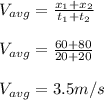
Physics, 14.02.2020 08:53 elicollierec
A car moves north at a constant speed of 3 ms^-1 for 20 s and then east at a constant speed of 4ms^-1 for 20s. What is the average speed of the car during this motion?

Answers: 2


Another question on Physics

Physics, 22.06.2019 03:50
The intensity of a polarized electromagnetic wave is 12 w/m^2. part a) what will be the intensity after passing through a polarizing filter whose axis makes the angle θ=0∘ with the plane of polarization? part b) what will be the intensity after passing through a polarizing filter whose axis makes the angle θ=30∘ with the plane of polarization? part c) what will be the intensity after passing through a polarizing filter whose axis makes the angle θ=45∘ with the plane of polarization? part d) what will be the intensity after passing through a polarizing filter whose axis makes the angle θ=60∘ with the plane of polarization? part e) what will be the intensity after passing through a polarizing filter whose axis makes the angle θ=90∘ with the plane of polarization?
Answers: 1

Physics, 22.06.2019 08:30
Pl asaaap ! match the term to the correct description. a type of wave that transfers energy where the particles in the medium move perpendicular to the direction in which the energy is traveling. a type of wave that transfers energy where the particles in the medium move parallel to the direction in which the energy is traveling. movement that is back and forth, like an equal sign = a type of wave that transfers energy where the particles in the medium move in a circle motion while the energy travels left or right. movement that is like a t transfers energy from one location to another 1. wave 2. parallel movement 3. perpendicular movement 4. transverse wave 5. longitudinal wave 6. surface wave
Answers: 1

Physics, 22.06.2019 13:00
Which of the following correctly describes what happens when an atomic bomb explodes? small pieces of fissionable material are joined and form a body with a mass greater than the critical mass, the relative number of neutrons escaping decreases, and a chain reaction and explosion result. large pieces of fissionable matter are brought together quickly and form a body with a mass smaller than the critical mass, the relative number of escaping neutrons increases, and a chain reaction and explosion result.
Answers: 2

Physics, 22.06.2019 19:00
The particle p starts from rest at point a at time t = 0 and changes its speed thereafter at a constant rate of 2.8g as it follows the horizontal path shown. determine the magnitude and direction of its total acceleration (a) just before point b, (b) just after point b, and (c) as it passes point c. state your directions relative to the x-axis shown (ccw positive) and choose the angle with the smallest magnitude.
Answers: 1
You know the right answer?
A car moves north at a constant speed of 3 ms^-1 for 20 s and then east at a constant speed of 4ms^-...
Questions


Social Studies, 10.05.2020 19:57

Mathematics, 10.05.2020 19:57



Mathematics, 10.05.2020 19:57

Mathematics, 10.05.2020 19:57


Computers and Technology, 10.05.2020 19:57

Biology, 10.05.2020 19:57


Mathematics, 10.05.2020 19:57

Medicine, 10.05.2020 19:57

Mathematics, 10.05.2020 19:57


English, 10.05.2020 19:57


Mathematics, 10.05.2020 19:57

History, 10.05.2020 19:57







